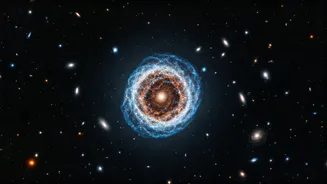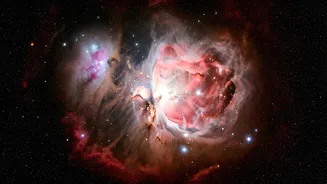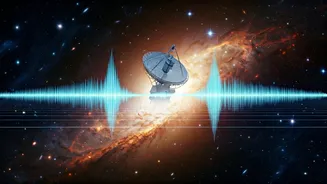Dark Matter's Enigma
Dark matter is a term used to describe a form of matter that is undetectable through our current instruments but exerts gravitational force. It doesn't
interact with light, making it invisible to telescopes. Scientists have proposed that dark matter makes up about 85% of the total mass of the universe, and its existence is inferred from its effects on visible matter, such as galaxies. For instance, the observed rotation speeds of galaxies cannot be explained by the visible matter alone; thus, scientists suggest the presence of a dark matter halo. Moreover, gravitational lensing, the bending of light by massive objects, also hints at the presence of dark matter. Despite its apparent abundance and impact, the actual composition and properties of dark matter remain elusive, which has led to numerous research activities for its identification.
Challenging Existing Models
Several theories have been put forward to describe and address the issue of dark matter. One of the main models involves Weakly Interacting Massive Particles (WIMPs). This theory suggests that dark matter is composed of particles that interact with the Standard Model particles only through gravity and the weak force. However, this is just one of many different possible theories, and scientists are still looking for other potential explanations. The challenges faced by scientists involve the fact that dark matter has not been directly detected in particle physics experiments. Another approach to understanding the missing mass problem is the modified Newtonian dynamics (MOND). MOND proposes an alteration of the law of gravity on a galactic scale, which can explain the observed galactic rotation curves without the need for dark matter. Each model offers different predictions, thus, researchers conduct various investigations to test these theories.
Galaxy Interactions & Cannibalism
Galaxies interact with each other in complex ways, and dark matter plays a critical role in these interactions. For instance, some of the recent findings indicate the presence of an extended dark matter halo around ancient dwarf galaxies. This suggests that galaxies have been consuming each other, a process known as galactic cannibalism. In this process, the larger galaxy pulls in smaller galaxies, thus altering the overall structure. The gravitational effects of dark matter are instrumental in shaping these interactions, and thus influence the formation and evolution of galaxies. Moreover, the study of these interactions helps scientists to understand how galaxies grow and evolve over billions of years. By observing the gravitational interactions, scientists get a better understanding of the distribution and effects of dark matter on larger scales.
Observing the Universe
Scientists use many tools and methods to understand the properties of dark matter. These methods include studying the rotation curves of galaxies, the gravitational lensing of light, and the cosmic microwave background (CMB). The rotation curves measure the speed at which stars and gas orbit the centers of galaxies. If the visible matter is the only source of gravity, the speed of orbiting objects should decrease further away from the center of the galaxy. However, in many galaxies, this speed is roughly the same at all distances. The CMB is the afterglow of the Big Bang and provides information about the early universe. By studying the distribution of matter in the CMB, scientists can gain insights into the distribution of dark matter. Furthermore, future projects, such as lunar radio telescopes, may provide new perspectives on this mystery by studying the radiation from the early universe.
Future Research Pathways
There are many future avenues for research on dark matter. Scientists are actively seeking new ways to directly detect dark matter particles. This includes experiments that use advanced detectors to identify the particles. Moreover, scientists are exploring alternative theories, such as modified gravity, which challenge the need for dark matter. The construction of more powerful telescopes and instruments will allow for detailed observations of distant galaxies. Also, data from various sources are being combined to provide a comprehensive view of dark matter. As technology advances and scientists refine their understanding of the universe, more mysteries of dark matter are likely to be revealed. This will bring us closer to comprehending the fundamental structure of the universe.












